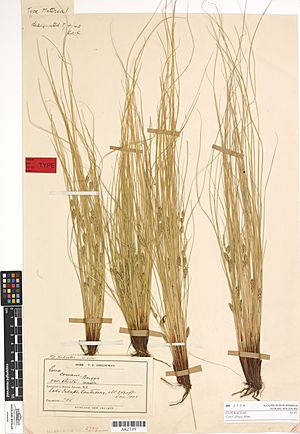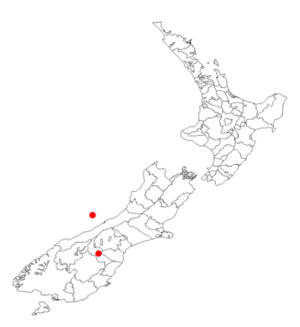Carex albula facts for kids
Quick facts for kids Carex albula |
|
|---|---|
 |
|
| Lectotype: AM AK2739-1 | |
| Conservation status | |
 Nationally Vulnerable (NZ TCS) |
|
| Scientific classification | |
| Genus: |
Carex
|
| Species: |
albula
|
 |
|
| Occurrence data from AVH | |
| Synonyms | |
|
Carex comans var stricta Cheeseman |
|
The white sedge, known scientifically as Carex albula, is a special type of grass-like plant called a sedge. It belongs to the Cyperaceae family, which includes many sedges and rushes. This plant is only found in the South Island of New Zealand.
Sometimes, plants can have different names. While some experts say Carex albula has no other names, the New Zealand Plant Conservation Network lists Carex comans var stricta Cheeseman as another name for it.
Contents
What Does White Sedge Look Like?
The white sedge grows in dense clumps. It can reach a height of 25 to 35 centimeters (about 10 to 14 inches). Its color can vary a lot. You might see it as a light tan, almost white, green, or even reddish.
The plant has smooth stems, called culms. These stems are usually 5 to 20 centimeters long and very thin, about 0.5 millimeters wide. They often have a deep groove along them. The white sedge has many leaves. The parts of the leaves closest to the ground, called basal sheaths, are dark brown to purple-red.
Flowers and Seeds
Like many plants, the white sedge has different parts for reproduction. It has separate male and female flower parts. The male flowers are found at the very top of the stem, while the female flowers are on other parts of the plant.
This sedge flowers from October to December. Its seeds, or nuts, develop and are ready from October all the way through September of the next year. These seeds are spread in a couple of ways. Sometimes, animals eat them and help spread them around. Other times, the wind carries the light seeds to new places.
Where Does White Sedge Grow?
The white sedge is found only in the South Island of New Zealand. You can spot it in areas like the Mackenzie Basin, Waitaki, and Central Otago.
It likes to grow in specific places. You'll often find it on flat areas next to rivers, called river flats. It also grows on elevated flat areas, known as alluvial terraces, and on gentle slopes.
Is White Sedge in Danger?
Scientists keep track of how many plants and animals are left in the wild. This helps them know if a species needs protection.
The International Union for Conservation of Nature (IUCN) has said the white sedge is of "least concern." This means it's not currently in danger globally.
However, in New Zealand, experts have a different view. Using the New Zealand Threat Classification System (NZTCS), they assessed the white sedge. In 2013, it was listed as "At Risk – Declining." This meant its numbers were going down. By 2017, its status changed to "Threatened – Nationally Vulnerable." This means it's still at risk and needs protection in New Zealand.

